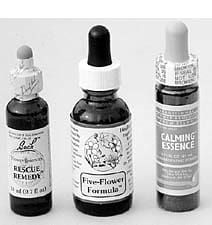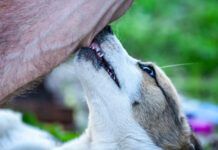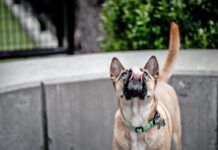[Updated December 3, 2018]
Everyone knows a thunderstorm horror story. A terrified dog leaps off a balcony or breaks through a plate glass window before jumping a fence, running into traffic, and meeting an unhappy fate. Or the animal simply disappears and is never seen again. More common and just as distressing are the panic attacks that overcome stay-at-home dogs when thunder roars or the neighbors light firecrackers.
Conventional veterinary medicine treats thunderstorm and other noise phobias with powerful tranquilizers or psychoactive drugs, none of which cure the patient and all of which have adverse side effects. These medications are really not a good solution to this syndrome, which disrupts the lives of many companion dogs, show dogs, and working dogs.
In May 1999, WDJ described an effective desensitization training program that has helped some thunder-phobic dogs, but as the article points out, the treatment is time-consuming, requires careful monitoring, and has a discouragingly low success rate in severely afflicted dogs.

In this article, we will discuss every other holistic remedy for thunder- and noise-phobic dogs.
Fear of Thunder in Dogs
Few veterinarians know as much about thunderstorm phobia as Nicholas Dodman, BVMS, MRCVS, author of The Dog Who Loved Too Much and Dogs Behaving Badly: An A-to-Z Guide to Understanding and Curing Behavioral Problems in Dogs.
Although thunderstorms are obviously noisy, Dr. Dodman suggests that the condition may not be caused by noise alone but by static electricity that generates painful shocks, especially in larger, heavy-coated breeds. “This is not to say that fear of loud noises (including thunder), darkening sky, lightning, wind noise, and rain are not also involved,” he explains, “just that they may be secondarily conditioned fears.”
In support of Dodman’s theory, dogs are often found hiding from storms in areas that provide excellent electrical grounding, such as bathtubs, showers, and the floor behind toilets; some clients have reported receiving electrical shocks from their dogs during storms; and when their owners applied anti-static products, some dogs became noticeably calmer.
Electrical fields may be magnified by storms, but they occur everywhere, and very large animals can be affected by stray electrical fields even in calm weather. The resulting “tingle voltage,” which strikes at random, can be measured with a voltage meter held to the affected animal. Dairy cows in shock from tingle voltage are unable to release their milk, which is how this phenomenon came to be discovered.
Perhaps there are two types of thunderstorm phobia, one induced by the discomfort of electrical energy in combination with loud noises (thunderstorms), the other triggered by sound alone (fireworks, gunshots, cannon fire, garbage trucks, airplanes, and other noises).
Although it affects some puppies, a fear of thunder more commonly develops in older dogs with no history of sound phobia. “In my experience,” says Dr. Dodman’s colleague, behavioral consultant Linda Aronson, DVM, “thunderstorm phobia is unusual in very young dogs.”
Belgian Shepherd breeder Judy Johnstone, who has a special interest in thunderstorm phobia, agrees. “I think a dog can be born with a propensity to be afraid of noise,” she says, “so it’s possible that a puppy or very young dog might develop this problem, but most of the dogs I know developed their phobias at two or three. My older dogs were that age when our house was hit by lightning, and both are still afraid of thunder.”
Most of the thunder-phobic dogs in Dr. Aronson’s practice developed their fear between ages four and seven. “This correlates to a decrease in thyroid function, which is an important component in behavioral problems,” she says. “In most cases the actual cause is unknown, but dogs that develop a fear of thunder for no apparent reason may do so because of some unwitnessed trauma.”
Treatment Options for Dogs Afraid of Thunder
Homeopathy
Homeopathy, the 200-year-old system of medicine that uses extremely dilute remedies, is popular with pet owners because it often works well and has no adverse side effects. Although nearly all of the trainers, owners, and therapists interviewed for this article tried homeopathy for thunderstorm phobias, it was either ineffective or, at best, helped only somewhat. “That’s not surprising,” says Larry Bernstein, VMD, president of the Academy of Veterinary Homeopathy. “Over-the-counter formulas that are sold for fear and anxiety combine several remedies and are given repeatedly. While this sounds sensible from a pharmaceutical point of view, combination remedies violate the rules of classical homeopathy, in which a single remedy is selected because it matches the patient’s symptoms and is given only once. Combination remedies tend to be most effective for acute infections and least effective for chronic conditions.
“Even classical homeopathy has a difficult time treating thunderstorm phobia,” he observes, “and its reduction or elimination often requires extended therapy. There is no specific treatment. All the books list Phosphorus, but I have not found it to be any more effective than other remedies for this condition. In homeopathy, you have to examine the whole syndrome, which means addressing not just the reaction to storms but all of a dog’s anxieties, the source of those anxieties, and everything else that’s going on in the dog’s life and mind. The owner working with over-the-counter remedies is at a serious disadvantage.”
Flower Essences
In the early 20th century, Edward Bach, an English physician and homeopath, placed small glass bowls filled with spring water and freshly picked blossoms in direct sunlight for three hours. He preserved and diluted the resulting flower essences with brandy.

Bach’s most famous preparation is a blend of five of his 38 remedies, now made by several different manufacturers and sold under the brand names Rescue Remedy (which is made by the company founded by Bach), Calming Essence, and Five Flower Formula. As its names suggest, this formula is appropriate for all emergencies; it combats shock, panic, and mental paralysis.
In addition to Bach’s original remedies, hundreds of flower essences are produced by practitioners around the world. “Flower essences have a subtle but profound effect on pets as well as people,” says Patricia Kaminsky, co-director of the 60,000-member Flower Essence Society. “They work best on behavioral and health problems that have an emotional cause.”
Drops can be massaged into the gums with a finger, placed on a small amount of bread or other soft treat, diluted with water and sprayed around the dog, squirted into the mouth, or added to a small amount of water that the dog will drink before the essences evaporate. Frequent application rather than dosage size is the key to success with this therapy. In addition, many herbalists and aromatherapists report good results from combining flower essences with herbal tinctures, essential oil blends, or distilled flower waters (hydrosols).
Rock Rose, a Rescue Remedy ingredient, is often used by itself to treat fear. Connecticut herbalist Christine Dunnak and her Royal Poodles lived in Vermont when a sudden storm so terrified the dogs that they fled and didn’t return for 24 hours. Their thunderstorm phobia intensified as the summer progressed. Today Rock Rose flower essence helps one of the Poodles stay calm during storms, and the other responds to Rock Rose followed by an herbal tincture.
Wisconsin dog trainer and laboratory animal technician Kathy Edstrom first tried flower essences when her younger German Shepherd, then two years old, became terrified of storms. He spent the night pacing, panting, and looking for places to hide, which made her older dog anxious as well. Edstrom experimented with Rock Rose, which she added to the dogs’ drinking water, and it made such a difference that, intrigued, she started classes with the Flower Essence Society. Her research led her to Aspen and Mimulus, which she combined with Rock Rose in equal parts. “Within two weeks of starting that combination,” she says, “my dogs were no longer afraid of thunder.”
Edstrom, now a flower essence practitioner, recently completed a case study on a three-year-old intact male Belgian Tervuren who was extremely frightened by thunder and other loud noises. After having six drops of the rock Rose/Mimulus/Aspen combination placed in his mouth three to four times a day, the dog’s behavior changed dramatically. Now instead of trying to climb into his owner’s jacket to hide, he remains calm and focused around gunshots, thunder, fireworks, and other distractions. “Correct application is essential,” says Edstrom. “At first the owner reported only slight improvement, but he was dosing the dog just once a day on a hard dog biscuit. As soon as he applied the drops three or four times a day, the transformation was amazing.”
Medicinal Herbs
Several herbs called nervines, which nourish and support the nervous system, are prescribed for all types of anxiety, panic, and hysteria, including thunderstorm phobias.
The most widely recommended nervine is the odoriferous valerian root (Valeriana officinalis). People either like valerian and call it earthy, or they gag over its raunchy “sweat socks” aroma. Cats are notorious for clawing through packages to reach it (valerian’s effect on them is similar to catnip), and many dogs enjoy its taste. Valerian’s volatile components are so fragile that the best way to preserve them is in a tincture or liquid extract made with fresh roots and alcohol, vegetable glycerine, or cider vinegar. Valerian loses much of its potency when dried at high temperatures, powdered for capsules, or exposed to light and humidity.
Valerian is nontoxic even in large amounts, and although often called a sedative herb and sleeping aid, it does not interfere with coordination. In fact, experiments conducted on humans show that valerian improves physical dexterity and mental focus. However, valerian doesn’t work for everyone; an estimated seven percent of humans (and possibly some dogs as well) react as though it contains caffeine or a similar stimulant. Try valerian when your dog is calm, and if it produces nervousness or agitation, substitute a different herb.
Although most tincture labels recommend small amounts, many of the herbalists polled for this article give their dogs generous doses. Tina Finneyfrock, an herbal practitioner in Earlville, NY, treated her 70-pound mixed-breed dog for thunderstorm phobia with valerian tincture and Rescue Remedy. “I gave the valerian as soon as I noticed her acting funny,” she says. “She always sensed a storm long before I did. I put 80 drops of undiluted valerian tincture on a small amount of wet food. It never made her pass out, but within 20 minutes, she was calm enough to weather most storms. If the thunder was severe, I gave her Rescue Remedy as well.”
Skullcap (Scutellaria laterifolia) is a sedative tonic herb with antispasmodic properties. It is used to control epilepsy in dogs as well as people, and it may help dogs who are sensitive to electrical fields. Skullcap tincture can be squirted into the sides of the mouth or given with food; start with 10 to 15 drops for an average size dog and repeat as needed at 15 to 20 minute intervals. An additional dropperful can be massaged into the skin on the back of the neck.
In Arizona, canine massage therapist and herbalist Lisa Walk combines valerian and skullcap for dogs with thunder phobias. “The dosage is higher than usual for herbal tinctures,” she says, “because extreme fear can override an herb’s effects. The same is true for prescription drugs, which is why veterinarians give heavier sedatives to dogs with panic disorders.
“With commercially prepared tinctures I start with one-third of the recommended human dose for a 50-pound dog, which is five to 15 drops, depending on the manufacturer,” describes Walk. “I then increase the dosage if necessary. A client’s German Shepherd needed 45 drops (three dropperfuls) to ease his panting, pacing, whining, and nervousness. To treat a Terrier-mix frightened by car travel, I started with 15 drops but found she needed 35 to feel comfortable. She weighed far less than the German Shepherd but needed proportionally more.” Walk recommends a raw, natural diet for its psychological as well as physical benefits and adds a mixture of nettles, oatstraw, and raspberry leaf, all of which nourish the nervous system, to the dog’s food.
Australian herbalist Robert McDowell, who specializes in herbal therapies for dogs and horses, has treated numerous cases of thunderstorm phobia using vervain (Verbena officinalis), a relaxing nervine, and St. John’s wort (Hypericum perforatum), best known as an antidepressent.
“Vervain is for the sensitive and rather ‘on edge’ nervous disposition in which spiraling reactions escalate out of control,” he explains, “and hypericum is for the nervous system which is so physically sensitive that loud noises actually produce pain as well as fright.”
For an average-size dog, McDowell recommends five drops of each tincture twice daily in food for at least three months, by which time the reaction pattern should be dramatically reduced. “The tincture should be made from fresh herbs at a 1:2 ratio,” he notes, “which is a very concentrated extract made with one pound of plant material for every two pounds of vodka or other liquid.” The herb companies listed in “Noise Phobia Resources” box on page 11 typically use this ratio.
McDowell recommends combining three fluid ounces (six tablespoons) each of vervain and St. John’s wort tincture to make a three-month supply for the average dog. To this mixture he adds two drops of each of the following flower essences: Mimulus for fear, Walnut for over-sensitivity, Rock Rose for the spiral energy of panic, Cherry Plum for the loss of control due to fear and panic, Honeysuckle to help break habit patterns established in the past, and Larch to support the self-confidence needed to trust the retraining process. Give five drops of the blend to small breeds, 10 drops to average-size dogs, and 15 drops to large-breed dogs. Administer the drops twice daily. The Polynesian herb kava kava (Piper methysticum) is a musculoskeletal relaxant that helps people and dogs cope with stress and distractions.
Because it prevents the muscle contractions that produce body postures characteristic of panic and hysteria, kava may prevent thunder phobia by maintaining a relaxed physiology, and it helps dogs respond to massage and other manipulations that realign the body.
In very large amounts, kava interferes with coordination and produces symptoms similar to alcohol intoxication; in humans, frequent overdoses produce an unsightly skin rash. Liquid extracts work faster than capsules or tablets, but both work well for most dogs. Follow label directions, giving giant breeds the amount recommended for humans; divide the recommended dose in half for dogs weighing 60 pounds, by four for 30 pounds, and by eight for 15 pounds. The dose can be repeated if necessary (dogs with a fast metabolism may need more and, as noted, so can dogs with extreme fear), or kava can be combined or alternated with valerian, skullcap, or other relaxing herbs.
Aromatherapy
To most Americans, aromatherapy means perfume, bath salts, air sprays, and similar products. One woman told Kristen Leigh Bell that she would like to try aromatherapy for her dog but felt uncomfortable at the thought of lighting candles on the floor all around him. “Mainstream aromatherapy is a booming business,” says Bell, a certified aromatherapist, “but it has nothing to do with the therapeutic use of pure, plant-derived essential oils and hydrosols.” Bell, who specializes in aromatherapy for dogs and cats, is completing a master’s degree at the highly regarded Pacific Institute of Aromatherapy. Her thesis topic is aromatherapy for pets.
In blending massage oils and spritzes that address thunderstorm phobias as well as other canine fears, Bell chose from a variety of essential oils that have proven sedative effects on the central nervous system.
“Some, such as basil (Ocimum basilicum) and ylang ylang (Cananga odorata),” she says, “are excellent for stress, anxiety, grief, and mental fatigue.”
Bell says the essential oils with the most profound calming effects are lavender (Lavandula angustifolia), valerian root (Valariana officinalis), spikenard (*Nardostachys jatamansi), mandarin petitgrain (the leaves of *Citrus reticulata), red or green mandarin (the peel of the same plant), sweet orange (*Citrus sinensis), sweet marjoram (*Origanum majorana), bergamot (the peel of *Citrus aurantium), and neroli (the same plant’s blossoms).
“My ‘Calm Down’ blend and ‘Fear/Anxiety’ blend share some of the same oils but are very different in scent,” Bell says. “Some clients find that using both blends works best for dogs with serious anxiety.”
Some who have used these blends to treat their dogs’ thunderstorm phobias and other noise-related fears combine the essential oil blends with flower essences, or they give an herbal capsule at the same time and, as the essential oils begin to wear off, the digested herbs become effective. “Essential oils have an almost immediate effect,” says Bell, “because when their volatile chemicals are inhaled and absorbed into a dog’s large and very active nasal cavity, they affect the central nervous system.”
Combining Remedies for Noise Phobia
Linda Walker, who raises Akitas in Michigan, took Speedo to her first dog show when the puppy was seven months old. “That was a big mistake on my part,” she says. “It was a National Specialty held outdoors under a huge white tent, and the noise level was astronomical, with big crowds, shrill whistles, and people screaming, yelling, clapping, and cheering. Speedo did well, including winning her class, but she was badly frightened, and she absolutely hated dog shows and loud noises after that.”
Walker tried Bell’s Calm Down and Fear/Anxiety blends in combination with the Rescue Remedy she had previously used alone without success. “I discovered that it works best to use Fear/Anxiety before leaving the van; then I switch to Calm Down,” she reports. “You can see the tension leaving her as soon as I spritz her chest and neck. It has taken some work, but by combining these spritzes with flower essence sprays and calming signals, we have made tremendous progress.” Walker also uses the blends for dogs who fear the veterinarian’s office.
To make a calming massage oil blend at home, Bell recommends mixing 10 drops of any of the essential oils listed above (15 drops for a large dog) with one ounce (two tablespoons) sweet almond, hazelnut, jojoba, sesame, or other cold-pressed vegetable oil. “Lavender, sweet orange, and marjoram are the least expensive therapeutic-quality essential oils,” she says, “and they are easy to find. The more daring might try valerian root, bergamot, and ylang ylang. Experiment until you find your dog’s favorite blend.”
To apply the oil blend, massage it into the dog’s neck and chest. “Always take advantage of making this a rewarding experience,” says Bell, “with lots of positive reinforcement.”
To make a spritz, mix 15 to 30 drops of essential oil with one ounce (two tablespoons) vodka and add enough water to make one cup of solution. Spray the air around your dog as often as desired.
Alternatively, apply several drops of essential oil to a bandana handkerchief and tie it around your dog’s neck, or purchase a nebulizing diffuser, which releases essential oils into the air.
Hydrosols, also called hydrolates, distillates, herbal waters, flower waters, or floral waters, are a by-product of the distillation process. They contain traces of essential oils and all of a plant’s water-soluble components, giving them the therapeutic properties of both an herbal tea and an essential oil. Because they are very dilute, hydrosols are safe for use on and around pets. They can be added to food or drinking water, applied topically, squirted into the mouth full-strength, sprayed on the animal, or sprayed around the room, car, crate, or kennel.
Jan Scanlan Coles lives in Toronto with four dogs, including two four-year-old Border Collies and their nine-year-old mother. One of the dogs hides downstairs whenever a storm begins. “I mix half a teaspoon of chamomile hydrosol with a small amount of bread or other soft food,” she says, “and that helps her stay calm.”
Suzanne Catty, one of the world’s leading authorities on hydrosols and the roommate of a Labrador Retriever, suggested chamomile to Scanlon, who works as her assistant. “The hydrosols of both Roman chamomile (Chamaemelum nobile) and German chamomile (Matricaria recutita) work well for stress and fear,” says Catty, “and so do neroli, lavender, and lemon balm (Melissa officinalis). In addition to giving the hydrosol by mouth, you can spray it on your hands and wipe them over the dog’s face, starting at the nose and moving back to and around the ears. Do this twice and repeat the treatment every few minutes until the dog is calm.”
Hydrosols make a very effective base for flower essence sprays. Because they are perishable, Catty recommends buying hydrosols from dealers who maintain fresh stock, transferring hydrosols to sterilized spray bottles as soon as they arrive, and storing them in a cool place. Discard any hydrosol that has an “off” odor.
More Remedies
Try these other ways to counteract your dog’s extreme fear of thunderstorms. Consider medication if your dog’s fear of thunder is still unmanageable after exploring other options.
Author CJ Puotinen is an herbalist, holistic pet care expert, the author of Encyclopedia of Natural Pet Care, and a frequent contributor to WDJ.





